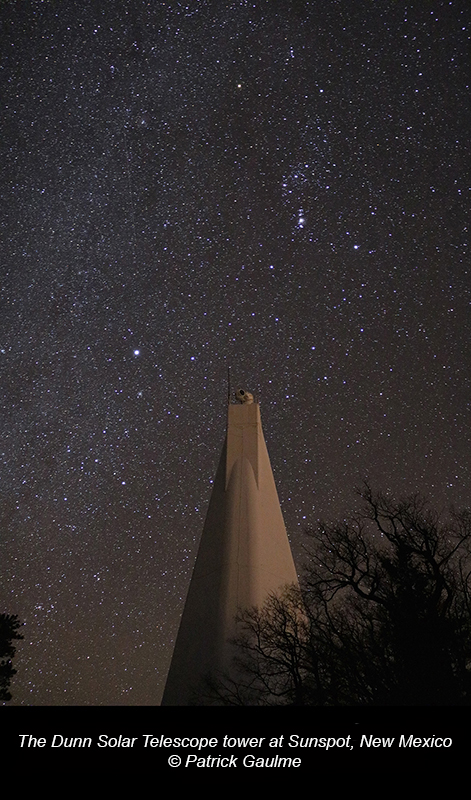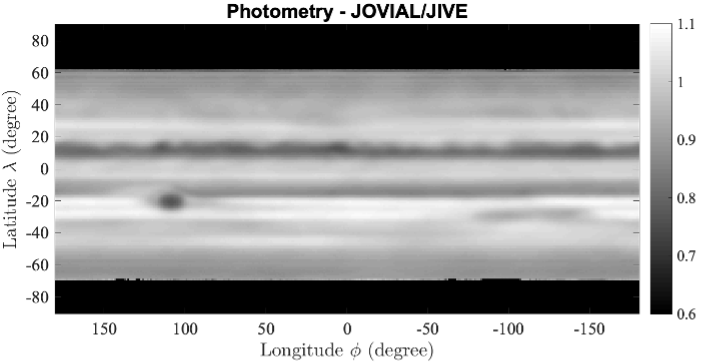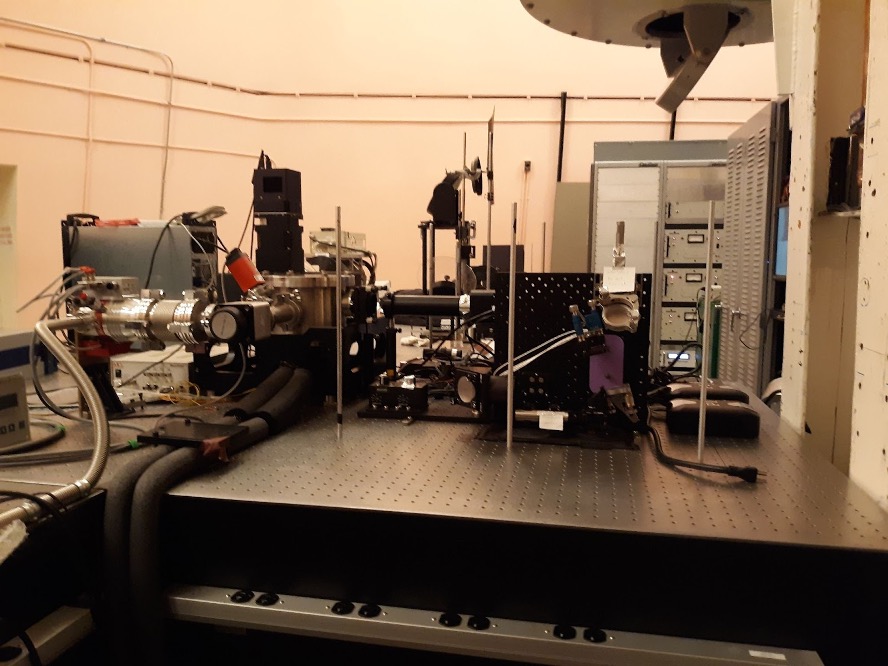An international team of scientists managed to produce the first map of the atmospheric circulation of Jupiter by using Doppler spectroscopy, whereas previous measurements were derived by measuring cloud motions from time-separated images. Such a technical performance was realized thanks to the imaging spectrometer JOVIAL specially dedicated to measuring motions in the atmosphere of Jupiter, which can be seen as a proof of concept for future space-borne instruments.
How hard is the wind blowing on Jupiter? A team led by Observatoire de la Côte d'Azur (OCA, France) and New Mexico State University (NMSU, USA) with collaborators from Japan, the USA, and Europe tried to answer that question with a new technique, in the frame of the JOVIAL project. So far, our knowledge about wind speed on the other solar system planets is obtained by taking pictures of them at different times, and measuring how much clouds move. The method is called cloud-tracking. It has been performed from images taken by space probes such as the NASA Voyager or Cassini missions, the NASA/ESA Hubble space telescope with the OPAL (Outer Planet Atmospheres Legacy) program, or even ground-based facilities.
Jupiter is famous for its banded structure, where winds circulate either eastward or westward depending on the latitude. The way the wind blows tells a lot about the interior of the planet and the way energy is transported from the inside out. "There are still many questions we're aiming at answering that could benefit from a complete view of the atmospheric dynamics of Jupiter'' says co-investigator Raúl Morales-Juberías, Associate Professor at New Mexico Institute of Mining and Technology (NM Tech). "The limitation of cloud tracking is that clouds evolve, even disappear, which certainly impacts the measurements”, says François-Xavier Schmider, director of research at OCA and JOVIAL principal investigator. In addition, "cloud tracking does not give access to vertical motions and has very limited capability for inferring meridional circulation (along meridians) for Jupiter because of the banded structure, whereas these are crucial for a complete understanding of energy transport", adds Schmider.
The alternative technique considered by JOVIAL consists of directly measuring the atmospheric motion through the Doppler effect. This effect refers to the change of wavelength that happens when an object that emits or reflects waves (light or sound) moves fast enough with respect to the observer. It can be heard as a change of tune in the case of sound waves, such as an ambulance passing by, or as a change of color in the case of light, which gets bluer when coming towards the observer and redder when moving away. Since the Doppler effect is sensitive to any displacement toward the observer, such measurements give – in principle – access to the three dimensions of atmospheric circulation. “Being able to measure the speed of vertical flows in Jupiter’s atmosphere would lead to major breakthroughs in understanding how heat and elements are transported from the planet’s interior" indicates co-I Tristan Guillot, director of research at OCA. directeur de recherche CNRS, laboratoireLagrange (Observatoire de la Côte d’Azur – Université Côte d’Azur - CNRS).
 The JOVIAL instrument is an interferometer that can produce an image of the planet together with its Doppler velocity map, by tracking the infinitesimal shift of spectral lines of the solar light reflected by Jupiter. The motions that were sought after are of the order of 100 meters per second, meaning shifts as little as 0.004 angstrom for a spectral line in the visible domain. The new results were obtained thanks to the NASA-EPSCoR granted project "Jovian Interiors from Velocimetry Experiment in New Mexico" (JIVE in NM) thanks to which a copy of the JOVIAL instrument was mounted at the focus of the Dunn solar telescope, located in Sunspot, New Mexico. "This historic telescope built in the 1960s by the US Air Force for studying the Sun has an excellent optical quality and the site benefits from optimal observing conditions" reports NMSU professor Jason Jackiewicz, PI of JIVE in NM.
The JOVIAL instrument is an interferometer that can produce an image of the planet together with its Doppler velocity map, by tracking the infinitesimal shift of spectral lines of the solar light reflected by Jupiter. The motions that were sought after are of the order of 100 meters per second, meaning shifts as little as 0.004 angstrom for a spectral line in the visible domain. The new results were obtained thanks to the NASA-EPSCoR granted project "Jovian Interiors from Velocimetry Experiment in New Mexico" (JIVE in NM) thanks to which a copy of the JOVIAL instrument was mounted at the focus of the Dunn solar telescope, located in Sunspot, New Mexico. "This historic telescope built in the 1960s by the US Air Force for studying the Sun has an excellent optical quality and the site benefits from optimal observing conditions" reports NMSU professor Jason Jackiewicz, PI of JIVE in NM.
After preliminary results published five years ago, where the mean zonal wind as a function of latitude was reported, the team reached a major milestone by producing a complete zonal velocity map of the planet, resulting from twelve nights of data. In other words: a two- dimensional map of the zonal winds as a function of latitude and longitude. This is the first time that such a map is obtained with such a technique for any of the giant planets. “It is stunning, I particularly enjoy seeing the great red spot standing apart in the zonal map”, says co-I Patrick Gaulme, a staff scientist at Thuringian State Observatory. The zonal wind map shows an excellent agreementwith results obtained by cloud tracking, which validates the technique.
In addition to the zonal wind map, the team publishes maps of the meridional and vertical atmospheric motions, even though these need to be taken more carefully. The reason is that those motions are more sensitive to noise than zonal flows, because of the way the signal is averaged to produce a map. The values that are found seem too large according to theoretical expectations. "We are in the situation that observers with a new instrument often face: is what we find something previously unknown that was inaccessible with existing instrumentation or is some weird behavior of our new instrument ?" says Gaulme. Science is built on research, which has intermediate steps where unexpected results need to be investigated longer.

Figure 1. Reconstructed image (left) and zonal velocity map (right) of Jupiter derived from the data obtained with JOVIAL/JIVE at Sunspot, NM, followed by a ground-based image of Jupiter (May 4th 2018). The red and blue color indicates eastward and westward winds, respectively. The maps are built by stacking twelve nights of data taken between May 4 and May 31, 2018. Data close to Jupiter’s poles were too noisy to be included in the averaged maps. The colour image of Jupiter was obtained by the amateur astronomer Damian Peach and processed by Peter Rosén (courtesy Peter Rosén).


Figure 2. Same as above but displayed in the form of a Mercator projection, as a function of longitude and latitude, expressed in degrees.
To firmly answer that question, new observations, with different instrumental settings will be needed, "weather and funding permitting" Jackiewicz adds. The next significant improvement will be obtained by connecting the JOVIAL instruments behind an adaptive optics device that will improve the spatial resolution on the planet and reduce possible biases in the measurements. "A game-changing setup would consist of placing a similar instrument in
space because 99% of our problems can be connected to atmospheric turbulence, which alters the measurements", says Schmider. In line with the top priority NASA Decadal Survey Uranus Flagship mission, a concept co-led by co-author Amy Simon, senior scientist at NASA Goddard, a Doppler imaging instrument with a focus on studying atmospheric dynamics would be invaluable. Meanwhile, the team is already working hard on analyzing new data taken in Summer 2023 by employing – for the first time – adaptive optics hopefully to drastically reduce the issues caused by Earth’s turbulent atmosphere.

The JOVIAL instrument on an optical table in the observing room at the Dunn Solar Telescope (picture from Cristo Sanchez)
Références
« Three-dimensional atmospheric dynamics of Jupiter from ground-based Doppler imaging spectroscopy in the visible », François-Xavier Schmider, Patrick Gaulme, Raúl Morales-Juberías, Jason Jackiewicz, Ivan Gonçalves, Tristan Guillot et al, Planet. Sci. J. 5 100 (2024)
Contacts
François-Xavier Schmider, directeur de recherche CNRS, laboratoire Lagrange (Observatoire de la Côte d'Azur - Université Côte d'Azur - CNRS), schmider@oca.eu.
Tristant Guillot, directeur de recherche CNRS, laboratoire Lagrange (Observatoire de la Côte d'Azur - Université Côte d'Azur - CNRS), Tristan.Guillot@oca.eu.







